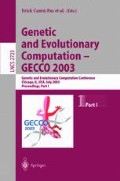Abstract
We present the result of our work on use of genetic programming for evolving social behavior of agents situated in inherently cooperative environment. We use predators-prey pursuit problem to verify our hypothesis that relatively complex social behavior may emerge from simple, implicit, locally defined, and therefore — robust and highly-scalable interactions between the predator agents. We propose a proximity perception model for the predator agents where only the relative bearings and the distances to the closest predator agent and to the prey are perceived. The instance of the problem we consider is more realistic than commonly discussed in that the world, the sensory and moving abilities of agents are continuous; and the sensors of agents feature limited range of “visibility”. The results show that surrounding behavior, evolved using proposed strongly typed genetic programming with exception handling (STGPE) emerges from local, implicit and proximity-defined interactions between the predator agents in both cases when multi-agents systems comprises (i) partially inferior predator agents (with inferior moving abilities and superior sensory abilities) and with (ii) completely inferior predator agents. In the latter case the introduction of short-term memory and explicit communication contributes to the improvement of performance of STGPE.
Access this chapter
Tax calculation will be finalised at checkout
Purchases are for personal use only
Preview
Unable to display preview. Download preview PDF.
References
Barborica, A., Ferrera, V.P., Estimating Invisible Target Speed from Neuronal Activity in Monkey Frontal Eye Field, Nature Neuroscience Vol.6, No.1 (2003) 66–74
Benda, M., Jagannathan, B., Dodhiawala, R.: On Optimal Cooperation of Knowledge Sources. Technical Report BCS-G2010-28, Boeing AI Center, Boeing Computer Services, Bellevue, WA (1986)
Brooks, R.A.: A Robust Layered Control System for a Mobile Robot. IEEE Journal of Robotics and Automation, Vol.2, No.1 (1986) 14–23
Ferber, J.: Multi-Agent Systems: An Introduction to Distributed Artificial Intelligence, Harlow: Addison Wesley Longman (1999)
Haynes, T., Sen, S.: Evolving Behavioral Strategies in Predators and Prey (1996)
Haynes, T., Wainwright, R., Sen, S., Schoenefeld, D.: Strongly Typed Genetic Programming in Evolving Cooperation Strategies (1997)
Holand, J.H.: Emergence: From Chaos to Order, Cambridge, Perseus Books (1999)
Koza, J.R.: Genetic Programming: On the Programming of Computers by Means of Natural Selection, Cambridge, MA, MIT Press (1992)
Luke, S., Spector, L.: Evolving Teamwork and Coordination with Genetic Programming
Miller, B., L., Goldberg, D., E.,: Genetic Algorithms, Tournament Selection, and the Effects of Noise, Illigal Report No. 95006, University of Illinois (1995).
Montana, D.: Strongly Typed Genetic Programming, Evolutionary Computation, Vol.3, No.2 (1995) 199–230
Morgan, C.: Emergent Evolution, New York (1923)
Morowitz, H.,J.: The Emergence of Everything: How the World Became Complex, Oxford University Press, New York (2002)
Parunak, H. Van D., Brueckner, S., Fleischer, M., Odell, J.: Co-X: Defining what Agents Do Together, Proceedings of the AAMAS 2002 Workshop on Teamwork and Coalition Formation, Onn Shehory, Thomas R. Ioerger, Julita Vassileva, John Yen, eds., Bologna, Italy, (2002)
Tanev, I.: DOM/XML-Based Portable Genetic Representation of Morphology, Behavior and Communication Abilities of Evolvable Agents, Proceedings of the 8th International Symposium on Artificial Life and Robotics (AROB’03), Beppu, Japan (2003), 185–188
Author information
Authors and Affiliations
Editor information
Editors and Affiliations
Rights and permissions
Copyright information
© 2003 Springer-Verlag Berlin Heidelberg
About this paper
Cite this paper
Tanev, I., Shimohara, K. (2003). On Role of Implicit Interaction and Explicit Communications in Emergence of Social Behavior in Continuous Predators-Prey Pursuit Problem. In: Cantú-Paz, E., et al. Genetic and Evolutionary Computation — GECCO 2003. GECCO 2003. Lecture Notes in Computer Science, vol 2723. Springer, Berlin, Heidelberg. https://doi.org/10.1007/3-540-45105-6_7
Download citation
DOI: https://doi.org/10.1007/3-540-45105-6_7
Published:
Publisher Name: Springer, Berlin, Heidelberg
Print ISBN: 978-3-540-40602-0
Online ISBN: 978-3-540-45105-1
eBook Packages: Springer Book Archive

